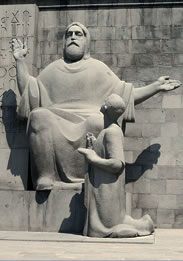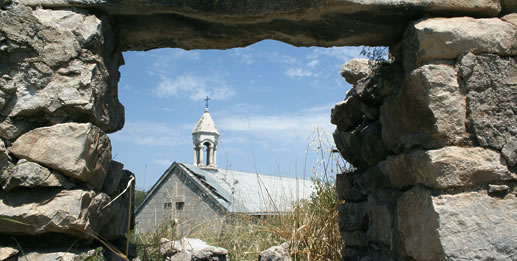Glossary
GLOSSARY OF KEY TERMS, CONCEPTS AND NAMES
Highlighted words and phrases are included and explained in Glossary
- AMARAS. Ruined medieval town near which the Amaras Monastery was built in the 4th century. Presumably destroyed during the invasion of the region by Tamerlane, in the 14th century.
- ARMENIAN ALPHABET. Unique alphabet for the Armenian language, invented in 406 AD (according to some sources—revived and developed from an earlier prototype) by St. Mesrob Mashtots (361-440 AD), an Armenian scholar, evangelizer and hymnist. St. Mesrob Mashtots toured Armenia’s province of Artsakh (modern Nagorno Karabakh) several times, and, according to tradition, established in Artsakh’s Amaras Monastery the first school where his script was used for teaching. St. Mesrob is buried at the Memorial Chapel in the town of Oshakan, near Yerevan.
- ARMENIAN APOSTOLIC CHURCH. Autocephalous church of Armenia established in the first century AD by two of Jesus Christ’s apostles—St. Bartholomew and St. Thaddeus (St. Jude). Since the early Middle Ages, Armenian Apostolic Church has retained doctrinal and administrative independence both from the Eastern Orthodox and Roman Catholic churche
- ARRAN. Semi-mythical Armenian patriarch and great-grandson of Hayk Nahapet (the eponymous ancestor of the Armenian people). Arran (Armenian: Առան) was regarded as the founder of the Arranshahik dynasty that ruled eastern Armenian lands in the Middle Ages.
- ARRANSHAHIKS. One of Armenia’s ancient patrician clan. Arranshahiks are named after Arran, a great-grandson of Hayk Nahapet (the legendary, eponymous forefather of the Armenians). Ultimately, Arranshahiks considered themselves direct descendents of Noah because Hayk was a great-grandchild of Japheth, who, in turn, was one of Noah’s three sons. Vachagan II the Pious, Armenia’s King of Aghvank — who is credited for re-discovering the relics of Amaras’ patron saint St. Grigoris in the 5the century — was a representative of the Arranshahik dynasty.
- ARTSAKH. Name of the 10th province of historical Armenia, according to traditional Armenian medieval geographical nomenclature. This term has been used by Armenians in reference to Nagorno Karabakh.
- AVETARANOTS. Historical town in Nagorno Karabakh’s region of Varanda (currently, in the Nagorno Karabakh Republic). In medieval times the town served as the administrative center of the Principality of Varanda, where the Amaras Monastery was located. Its name derives from the Armenian word avetaran (Armenian: ավետարան), which means “Gospel.”
- CONSTITUTION OF AGHVEN. Seminal 5th century constitutional edict that established foundations of Armenian legal thought. Features as part of the Old Armenian historical compilation known as the History of the Province of Aghvank. Consists of 21 tenets (canons). Endorsed by King Vachagan II the Pious and co-signed by 14 Armenian dignitaries from early medieval Nagorno Karabakh and adjacent territories.
- GANDZASAR MONASTERY. Armenian Apostolic Church’s monastery and former patriarchal see located in the Nagorno Karabakh Republic, in Armenia’s historical province of Artsakh. The monastery was built from 1216 to 1261 by Prince Hasan Jalal Vahtangian, and completed by his descendents by 1266. The headquarters of the Katholicosate of Aghvank moved from the Amaras Monastery to the Gandzasar Monastery in the 14th century, and became known as the Holy See of Gandzasar.
- DIOCESE OF ARTSAKH. Present-day division of the Armenian Apostolic Church responsible for the activity of the church in the Nagorno Karabakh Republic and adjacent lands associated with Armenia’s historical province of Artsakh. The Diocese of Artsakh is considered as the historical successor of the Holy See of Gandzasar and the Katholicosate of Aghvank.
- HAYK NAHAPET. Eponymous ancestor of the Armenian people in whose honor Armenians call themselves “Hye” (pronounced “high;” Armenian: Հայ), and their country—“Hayq” (Armenian: Հայք). “Hayk Nahapet” means Hayk the Progenitor or Hayk the Forefather. Vachagan II the Pious — Armenia’s King of Aghvank who re-discovered the relics of Amaras’ patron saint St. Grigoris in 489 AD — and his descendents claimed a direct link to Hayk Nahapet.
- HOLY SEE OF GANDZASAR. Name of the headquarters of the easternmost subdivision of the Armenian Apostolic Church, known in the past as the Katholicosate of Aghvank. Similarly to several other subdivisions of the Church, the Holy See of Gandzasar retained a degree of autonomy from the Church’s Mother See (seat of the Katholicos of Armenia and All Armenians) in the Middle Ages.
- HINDEGHNA GRAPES. Black grapes native to eastern regions of historical Armenia, such as Artsakh (Nagorno Karabakh). According to local lore, Hideghna grapes have special medicinal qualities because they grow in the vicinity of the Amaras Monastery, and thus are under the divine sponsorship of the monastery’s patron, St. Grigoris, and St. Pantaleon the Healer (whose remains also are found at the monastery). Its designation in Russian is Hindogny – Хиндогны. The name of the grapes originates from the words hin (Armenian: հին), meaning “old,” and degh (Armenian: դեղ), meaning “medicine.” Hindeghna was also the name of a table wine produced in the USSR’s Nagorno Karabakh Autonomous Region.
- KATHOLICOS. The head archbishop of Armenia’s national church, Armenian Apostolic Church. This title was also used to describe heads of several subdivisions of the Armenian Apostolic Church in medieval times, such as the Katholicos of Aghvank, Katholicos of the Great House of Cilicia and Katholicos of Akhtamar. Katholikos is also spelled as “Catholicos;” Armenian: Կաթողիկոս. The word is a transliteration of the Greek word καθολικός (plural καθολικοί), meaning “universal” or “general.”
- KATHOLICOSATE OF AGHVANK. Subdivision of the Armenian Apostolic Church that was in charge of parishes in Armenia’s historical provinces of Artsakh and Utik, and all lands east of Armenia’s traditional border. The Amaras Monastery had served as the headquarters of the Katholicosate of Aghvank for a long time. The rise of the Principality of Khachen in the 13th century made the Katholicosate of Aghvank and the Holy See of Gandzasar synonymous concepts. The Katholicosate of Aghvank played an important role in the Armenian national liberation movement of the 1720s-1730s.
- KHACHKAR. Unique-to-Armenia stone monuments with engraved Christian cross or several crosses. Khachkars are used for funerary and other memorial purposes. As most Armenian monasteries, the Amaras Monastery has a number of khachkars. The word khachkar (Armenian: խաչքար) means “cross-stone,” with “khach” meaning cross and “kar” meaning stone.
- KINGDOM OF AGHVANK. Early medieval Armenian-ruled kingdom that was formed by the merger of the lands of the so-called “original Aghvank” (also known in Western academia as “Caucasian Albania” or “Caspian Albania”) and Armenia’s former provinces of Artsakh and Utik whose rulers acquired more autonomy after the partition of the Kingdom of Armenia in 387 AD. According to a legend discussed in early medieval Armenian history texts (such as the fifth century’s “History of Armenians” by Movses Khorenatsi), the term “Aghvank” derives from the nickname “Aghu” (աղու, meaning “kindhearted” in Armenian) given to the epic ruler of eastern Armenian provinces—Patriarch Arran. Rulers of the Kingdom of Aghvank were known for their strong support of Armenian culture and religion. King Vachagan II the Pious rediscovered the relics belonging to St. Grigoris, the patron saint of the Amaras Monastery, in 489 AD. It was in the Kingdom of Aghvank, where the inventor of the Armenian Alphabet St. Mesrob Mashtots opened the first school where his script was used.
- MARUT. Semi-legendary azgapet (chieftain) from Varanda Valley. Mentioned in the History of the Province of Aghvank, a 7th to 10th century Old Armenian manuscript attributed to Movses Kaghankatvatsi, as a co-signee of the Constitution of Aghven.
- MARUTANTS CLAN. Family with origins in the town of Avetaranots and the nearby village of Syghnakh, in Nagorno Karabakh’s Varanda Valley. According to the legend, the family was founded by azgapet (chieftain) Marut, a confidante of Aghvank’s ruler King Vachagan II the Pious and a practitioner of herbal medicine. Healers from the Marutants Clan used Hindeghna grapes that grow in orchards near the Amaras Monastery to cure a range of diseases, mainly associated with the malfunction of the immune system. The grapes were believed to have special medicinal qualities supposedly derived from the supernatural influence of the monastery’s saints and spiritual patrons — St. Grigoris and the early Christian healer St. Pantaleon the Healer.
- MELIK. Feudal lords (dukes) in some regions of the Southern Caucasus, most notably—in Armenia’s eastern provinces of Artsakh, Syunik and Utik. The word melik means “king” in some Semitic languages. Rulers of the Principality of Varanda, on whose lands the Amaras Monastery stands, held the title of meliks.
- MELIKDOM (MELIKATE). A principality in late medieval Armenia ruled by a melik. The Principality of Varanda, where the Amaras Monastery was located, was a melikdom.
- MONASTERY OF HOLY TRANSLATORS. Also known as the Targmanchats Monastery (Armenian: Թարգմանչաց վանք), it is a 5th century monastery on the territory of Armenia’s historical province of Artsakh (modern Nagorno Karabakh and adjacent lands). The monastery is one of several holy places in Artsakh associated the Holy Translators of the Bible, i.e. the inventor of the Armenian alphabet Saint Mesrob Mashtots and his spiritual associate and sponsor Katholicos Sahak Partev. It is located to the north of the Nagorno Karabakh Republic, in Artsakh’s district of Gardman. According to the Armenian historian Movses Kaghankatvatsi (7th century), the monastery was founded by Saint Mesrob Mashtots during one of his two trips to Artsakh and Utik in circa 410 AD.
- NAGORNO KARABAKH. Western cliché used to describe the territory of the USSR’s former Nagorno Karabakh Autonomous Region and the post-Soviet Nagorno Karabakh Republic.
- NAGORNO KARABAKH AUTONOMOUS REGION. The USSR’s territorial autonomy for ethnic Armenians who constituted majority population in Nagorno Karabakh. The Nagorno Karabakh Autonomous Region (NKAR) was administratively subordinated to Azerbaijani Soviet Socialist Republic in the beginning of the 1920s, by the Soviet dictator Joseph Stalin — amid vocal protest of the region’s Armenian natives. NKAR’s link to Soviet Azerbaijan proved unsustainable: as soon as Moscow’s rule in the Southern Caucasus weakened in the late 1980s, NKAR’s population and leadership unanimously voted to secede from Soviet Azerbaijan and join Soviet Armenia. The secession constituted a prelude for the subsequent establishment of the Nagorno Karabakh Republic, in 1991. Azerbaijani administrators from Baku suppressed religious freedom in NKAR. As a result, the Nagorno Karabakh Autonomous Region became known as the only autonomy in the USSR, which did not have a single functioning Christian temple despite the fact that its population was predominantly Christian — from 96 percent in 1926 to 80 percent in 1987.
- NAGORNO KARABAKH REPUBLIC. De-facto independent state in the Southern Caucasus region that emerged after the collapse of the Soviet Union and breakup of the USSR’s Azerbaijani Soviet Socialist Republic in 1991.
- PRINCIPALITY OF VARANDA. Armenia principality in Nagorno Karabakh, historical Artsakh, on whose territory the Amaras Monastery is located. Ruled by the Melik-Shahnazarian dynasty from the 16th century to the 19th century. Together with Nagorno Karabakh’s principalities of Khachen, Jraberd, Giulistan, and Dizak, the Principality of Varanda was one of the five Armenian feudal formations, which continued the tradition of Armenian statehood after the disintegration of the Kingdom of Armenia. Lords of Varanda, and other princes of Nagorno Karabakh, maintained direct correspondence with royal houses of Russia, Europe and Iran, and were often recognized by them as representative of the collective will of the Armenian people in the in late medieval period.
- SAINT ECHMIADZIN. Historical headquarters of the Armenian Apostolic Church located in the city of Vagharshapat, Armenia, and founded in the beginning of the fourth century. Saint Echmiadzin houses the seat of the Katholicos of All Armenians — the supreme patriarch and religious leader of Armenian Christians.
- SAINT GRIGORIS. Patron saint of Artsakh (Nagorno Karabakh) and the Amaras Monastery, born in 322 AD. Grandson of St. Gregory the Enlightener (St. Gregory the Illuminator), who turned his country into the world’s first state in 301 AD. St. Grigoris is known for his mission in the Northern Caucasus where he preached the Holy Gospel to pagan tribes. Martyred at the hand of King Sanesan of the Massagetans. St. Grigoris is buried in the underground mausoleum in the monastery’s church that bears his name.
- SAINT GREGORY THE ENLIGHTENER. Armenia’s most important saint known for converting the Kingdom of Armenia into the world’s first Christian state in 301 AD. Among St. Gregory’s many accomplishments is his foundation of the Amaras Monastery in Artsakh (modern Nagorno Karabakh) in circa 330 AD.
- SAINT MESROB MASHTOTS. Medieval scholar, theologian, hymnologist and political figure who invented the Armenian Alphabet in 406 AD. The Amaras Monastery hosted the first school where St. Mesrob’s alphabet was taught to pupils, in circa 410 AD.
- SAINT PANTALEON. Also known as Saint Panteleimon. Legendary early Christian healer and martyr who lived between 275 AD and 303 AD in Asia Minor. The cult of St. Pantaleon was prominent in Utik and Artsakh (Nagorno Karabakh) in medieval times. According to a popular belief in Nagorno Karabakh, Hindeghna grapes that that grow in orchards near the Amaras Monastery have medicinal qualities because the monastery hosted holy relics that belonged to Saint Pantaleon and Saint Grigoris.
- STEPANAKERT. Capital of the Nagorno Karabakh Republic.
- SYUNIK. Name of the 9th province of the historical Armenia, according to traditional Armenian medieval geographical nomenclature. Most of its territories overlap with the modern Province (“marz”) of Syunik of the Republic of Armenia. Syunik borders the province of Artsakh from the west, and has maintained strong historical, ethnological and cultural connection to Artsakh. Artsakh was often referred to through the Middle Ages as Lesser Syunik.
- SYGHNAKH. Village in Nagorno Karabakh’s province of Varanda. Served as a recruiting center for the Principality of Varanda. The village’s population traditionally provided military services for the Lord of Varanda by forming the backbone of the principality’s armed force. In compensation for the services, the Lord of Varanda exempted the village from taxation and awarded its elders arable land near the Amaras Monastery. There, the Marutants Clan — Syghnakh’s ancient practitioners of folk medicine — cultivated the Hindeghna grapes, whose healing power was said to derive from the divine sponsorship of Amaras’ patron saints.
- UTIK. Name of the 12th province of historical Armenia, according to traditional Armenian medieval geographical nomenclature. It included territories located north and north-east of Artsakh, the 10th province. Most territories that comprised medieval Utik lie within the borders of modern Azerbaijani Republic; the north-western extremity of Utik covers a portion of the Province (“marz”) of Taush in the Republic of Armenia.
- VACHAGAN II THE PIOUS. Ruler of Armenia’s Kingdom of Aghvank who lived in the 5th century. Known for his effort to find St. Grigoris‘ relics near the Amaras Monastery. The discovery took place in 489 AD, an event described in detail in the 7th century Old Armenian historical text History of the Province of Aghvank. King Vachagan spent his last years in a town in Varanda Valley that was named Avetaranots in recognition of the King’s studies of the Holy Gospel (Avetaran, in Armenian). Vachagan II the Pious appears as a key character in a number of Armenian fairytales and legends.
- VARANDA VALLEY. Valley in the central part of modern Nagorno Karabakh, the main geographic feature of the region of Varanda. The valley is flanked by the Artsakh and Bovurkhan mountain ranges. The Amaras Monastery is located in the southeastern extremity of the Varanda Valley.




